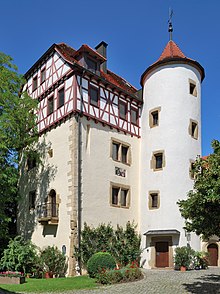Münchingen (noble family)


Münchingen is the name of an old Swabian noble family . The family belongs to the Uradel in Glemsgau .
history
origin
The family with Rüdiger von Münchingen was first mentioned in a document in 1157. The uninterrupted line of the family begins with Heinrich von Münzingen called Keller , who is called around 1260.
Münchingen, which gave the family its name, is now part of the town of Korntal-Münchingen in the Ludwigsburg district in Baden-Württemberg . It was first mentioned in 1130 in the Zwiefalter Chronicle.
Spread and lines
Of the four sons of the progenitor Heinrich von Münzingen, the second son, Hugo Franz († 1313), was able to continue the tribe permanently. His sons Reinhard and Werner divided the sex into two lines. The younger line founded by Werner expired in 1491 with the death of his great-grandson Wilhelm. The older line established by Reinhard was continued by his older son Werner II.
Several of the early family members entered the service of the Church, but also in secular orders and organizations. From the 14th century on, the heads of families were in the service of the ruling House of Württemberg almost continuously and held influential court and military offices. Friedrich Benjamin von Münchingen died in 1658 as the Duke of Württemberg chamberlain and stable master .
The descendants of Werner II in the 10th generation were the brothers Siegfried and Ludwig. Siegfried von Münchingen (* 1776) was a royal Württemberg lieutenant general and chief stableman. His brother Ludwig von Münchingen (* 1765) became a grand ducal chamberlain and colonel in Baden . He was married twice, first to Charlotte von Pflugk and second to Octavie von Flachslanden. From the former came Amalie von Münchingen (* 1797), who married the ducal saxony-coburg-gothaschen state chief hunter Freiherr von Wangenheim in 1822 . From the second marriage, there were three daughters, Antonie (* 1814), Camille (* 1819) and Adelheid (* 1823), a son, Anton (* 1823). In 1832, Antonie von Münchingen married the royal chamberlain from Württemberg and chief forester Rudolph Hiller von Gärtingen in Hohenzollern- Hechingen.
The title of baron was held by members of the family because they belonged to the Swabian imperial knighthood.
Possessions
The Münchingen parent company was exchanged for the nearby knight's seat in Ditzingen in the middle of the 15th century . In the 17th century, some of their ancestral estates came back into family ownership. Friedrich Benjamin of Münchingen was in 1652 by Duke Eberhard von Württemberg with the manor to Münchingen invested .
In 1397/1398 Wilhelm and Hug von Münchingen were enfeoffed half with Hochdorf (now part of Eberdingen ) with high and low jurisdiction . It remained in the possession of the von Münchingen family until the beginning of the 18th century. Because of their high indebtedness, Franz Karl von Münchingen and his two brothers Wolfgang Ludwig and Eberhard Friedrich sold their Hochdorf property in 1709 for 20,000 guilders to Philipp Heinrich von Ticino with the ducal approval .
Because of the ownership of Hochdorf and of the Münchingen estate and castle, which were sold to von Harling in 1733, the Lords of Münchingen belonged to the Imperial Knighthood in the knightly canton of Neckar-Black Forest of the Swabian knightly circle in the 18th century . Also in the 18th century they were enrolled in the knightly canton of Kocher because of the ownership or partial ownership of Schlossgut Bittenfeld, sold to von Nettelhorst in 1700 .
coat of arms
Family coat of arms
The coat of arms shows an erect, crowned, black lion in silver . The lion growing on the helmet with the black and silver helmet covers .
Coat of arms history
The coat of arms appears on imprints of seals . In Johann Siebmacher's Wappenbuch (1605) the lion turns left with white flames on his chest. In the supplement to Siebmacher's coat of arms, the lion in the shield and on the helmet is turned to the left in white at the top and black at the bottom. In Konrad Tyroff , crests of the whole nobility of the Kingdom of Bavaria (1842), the upper part of the growing silver lions on the helmet with both front paws, the lower part of black.
literature
- Ernst Heinrich Kneschke : New general German nobility lexicon . Volume 6, Friedrich Voigt's Buchhandlung, Leipzig 1865, pages 409-410. ( Digitized version )
- Ernst Heinrich Kneschke : The coats of arms of the German baronial and noble families . Volume 2, TO Weigel, Leipzig 1855, pages 309-310. ( Digitized version )
- Genealogisches Handbuch des Adels , Adelslexikon Volume IX, Volume 116 of the complete series, page 273; CA Starke Verlag , Limburg (Lahn) 1998, ISSN 0435-2408
Web links
- Coat of arms of those of Münchingen in Johann Siebmacherswappenbuch in 5 volumes (1701)
- Coat of arms of those of Münchingen in the Württemberg coat of arms book, page 34 and no.119 (1846)
Individual evidence
- ↑ Certificate of the Hirschau monastery in the main state archive in Stuttgart
- ↑ a b c d New General German Adels Lexicon Volume 6, Page 409
- ^ A b c Genealogical Handbook of the Adels , Adelslexikon Volume IX, Volume 116 of the complete series, page 273
- ↑ www.korntal-muenchingen.de
- ↑ www2.landesarchiv-bw.de
- ^ Gerhard Köbler : Historical Lexicon of the German Lands. The German territories from the Middle Ages to the present. 7th, completely revised edition. CH Beck, Munich 2007, ISBN 978-3-406-54986-1 , p. 441.
- ^ The coats of arms of the German baronial and noble families , Volume 2, pages 309-310

